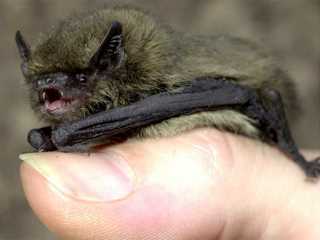I was rambling idly through the pages of a back issue of the New Yorker when my eye happened on this sentence:
'At Aeolus Cave, in Vermont, the ground is littered with bat bones. There are so many of them - thousands upon thousands - that you can't take a step without crunching them underfoot'.
The piece went on to reveal that the bat population of the cave had been decimated by the disease, white-nose syndrome, or Geomyces destructans.
It was estimated that 'almost three hundred thousand overwintered in the cave in 2007 but today the count was a hundred and twelve'.
Now I like bats, so this came as something of a shock to me as I had not heard that bats were under threat, let alone that their populations were being decimated by disease in Vermont.
I like bats not least because my workplace is a dilapidated old mill beside a tree-lined river - in other words the sort of real-estate favoured by bats - so they and I have been companions for the last thirty-five years and more.
And, on warm summer nights when we sit outdoors, we watch what seem like clouds of bats feeding over the river: I say 'seems like clouds' as it is impossible to count bats in flight because they swoop and turn at such incredible speed that you cannot tell whether you are looking at one bat or another and, since they feed at dusk when the light is fading, visual observations are further impaired.
This unfortunate Long Eared Bat fell into wet lacquer in the workshop, unfortunately destroying himself and not improving the finish on my piece of funiture!
On another occasion I found a little pipistrelle bat in the sink in our kitchen: how it got there I have no idea.
Anyway, it seemed perky so I hung it in ivy down near the mill and beside the river, thinking that thereabouts it would be within its habitat.
It rained heavily overnight and in the morning I went to check on my bat. It was still hanging there but with rainwater dripping off its nose!
However it, by now named Pip, was still very much alive so I put him in the hot-press to dry-off and warm-up!
That evening I hung Pip in ivy again, but this time high on the side of the mill hoping that that would afford him better better protection from the rain.
He was gone by morning: whether he fell and was consumed by a predator or took flight I will never know: I trust the latter.

A Pipistrelle Bat
I hope our, and in particular my mill bats remain free of the 'white nose syndrome' and will continue to thrive and keep me company.
I shall keep a special eye out for them this season.
And this threat to bats reminded me of another species that has been decimated in recent years. Bees.
I'm fond of bees too as they have also long been my companions in the mill.
In the apex of the south-facing gable of the mill, we had, until last year, a nest of wild bees that had been there since I came here.
In later years they shared the space with a pair of pigeons who arrived one day and decided to stay.
I'm not quite sure what class of pigeon they were but they certainly weren't the common wood pigeon, nor were they street or city pigeons so we decided that they must be homeing pigeons who had decided to chuck-in the competative effort and settle for a quiet life in the beautiful Arrigle valley!
They came and went over a number of years but there has been no visit for a while now.
And all this set me thinking about the general decline in the quantity and variety of wildlife that has taken place over the years we have been here.
When our children were small it was a Sunday ritual that we would drive into Thomastown in the early morning to buy the papers and treats.
And a part of the ritual was that we would go via a higher, less used, road than the more direct Rock Road between Dysart and the town. - In fact this road is still known within the family as 'the Sunday road'.
And on those journeys, especially in spring and summer, it was necessary to drive at a crawl to allow rabbits time to scurry to safety.
And also at that time, when driving the aforementioned Rock Road in the dark, it would be unusual not to see at least one badger. The terrified creatures would often run ahead of the car seemingly mesmerized by the headlights. Many and many a time I had to stop and turn-off the lights to break the spell and allow them to veer off the road.
Foxes and their cubs were a regular sight.
We would spot hares and otters from time to time.
Red squirells were still holding their own against the grey squirell, which subsequently became a plague.
Swallows were plentiful and were also my companions in the mill.
Herons were daily visitors, both in flight and fishing the river.
If I lifted my head when at my desk, tree-creepers would divert me from my work for hours and and fly catchers, dancing in the air, were an equal diversion.
All of these creatures, even the rabbits, are now either greatly reduced in numbers or rarely to be seen, if at all.
What has happened? What have we done?

